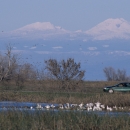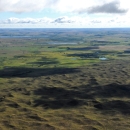Visit Us
Fort Niobrara NWR provides numerous recreational opportunities to thousands of visitors every year. During your visit, you can enjoy viewing the unique geology and diverse wildlife and plants whether driving, hiking, or river floating. You can learn more about wildlife and their habitats by stopping at kiosks and the Visitor Center on the Refuge. The Visitor Center is open Monday-Friday, 9-4 PM. We also offer hunting and fishing. Read on for more details about recreational opportunities!
Activities
Various grassland birds may be seen along Refuge roads including grasshopper sparrow, western meadowlark, horned lark, upland sandpiper, long-billed curlew, burrowing owl, and northern harrier during the spring and summer months. Woodland habitats along the Niobrara River offer great birding opportunities during late spring and summer months. Depending upon the time of year, bison may be viewed from the Refuge roads. Refuge visitors have access to multiple trails and overlooks, and thousands of Refuge visitors connect with nature by floating the Niobrara River.
Trails
Fort Niobrara Refuge offers two hiking trails, the Fort Falls Hiking Trail and the Wilderness Access Foot Trail. Both trails offer interesting views of wildlife and their various habitats.
Fort Niobrara Wilderness is open to exploration on foot during daylight hours. Camping is prohibited. Access the wilderness area wilderness area
Wilderness areas are places untamed by humans. The Wilderness Act of 1964 allows Congress to designate wilderness areas for protection to ensure that America's pristine wild lands will not disappear. Wilderness areas can be part of national wildlife refuges, national parks, national forests or public lands managed by the Bureau of Land Management.
Learn more about wilderness area via the Wilderness Access Foot Trail near the corrals. Access to the river is from the Refuge canoe launch.
Other Facilities in the Complex
Lacreek Refuge lies in the shallow Lake Creek valley on the northern edge of the Nebraska Sandhills and includes 16,410 acres of native sandhills, sub-irrigated meadows, impounded fresh water marshes, and tall and mixed grass prairie uplands. The Refuge serves as an important staging area for migrating waterfowl, sandhill cranes, shorebirds, and neotropical migrants. The Refuge provides critical wintering habitat for the High Plains trumpeter swan population.
Valentine Refuge is 71,516 acres and is located in the Sandhills of north-central Nebraska. The Refuge is a unique and important natural area of the National Wildlife Refuge System which includes more than 566 National Wildlife Refuges spanning approximately 100 million acres of lands and 750 million acres of oceans in the United States. The native prairie and wetlands found here support a diversity of wildlife. Little has changed from historic times. The Refuge was established by Congress in 1935 “as a breeding ground for migratory birds and other wildlife” and is home to 270 species of birds, 59 species of mammals, and 22 species of reptiles and amphibians.
Crescent Lake Refuge lies on the southwestern edge of the Nebraska Sandhills, the largest sand dune in the Western Hemisphere. The Sandhills are characterized by rolling, vegetated hills and interdunal valleys. These habitats on the Refuge are interspersed with 21 wetland complexes—shallow lakes, marshes, seasonal wetlands, wet meadows, and a small stream. Wildlife diversity, except large ungulates and their predators, is relatively unchanged since early settlement.
North Platte Refuge was established in 1916 by Executive Order No. 2446 as a “preserve and breeding ground for native birds.” It is located in the Nebraska Panhandle, near Scottsbluff. It was declared a National Wildlife Refuge primarily because of fall concentrations of up to 250,000 Mallards, 11,000 Canada Geese and Bald Eagles.
John W. and Louise Seier Refuge is found in north-central Nebraska, as a protected place for wildlife among the Sandhills. The Sandhills region is the largest remaining tract of mixed and tall grass prairie in North America. The Seier Ranch was originally homesteaded by John and Louise Seier’s grandparents in the mid-1800's. John and Louise Seier did not have any immediate family, but did have a love of wildlife and an interest in preserving wildlife, they donated, their 2,400 acre working cattle ranch to U.S. Fish and Wildlife Service in October of 1999. Because the Refuge is new to the System, it remains closed to the public at this time. There is no projected date for the opening of the Refuge, however, a date will be established upon the completion of a management plan.
Rules and Policies
There are lots of fun, interesting, and educational things you can do and enjoy at Fort Niobrara National Wildlife Refuge. When in doubt about rules or regulations regarding a specific activity, please check with the Fort Niobrara NWR office before participating in that activity. Be safe and have fun!
To protect the wildlife, habitats, and historic resources of Fort Niobrara NWR and to make your visit more enjoyable, the following regulations are strictly enforced:
- The Refuge is open to the public during daylight hours only.
- Vehicles must stay on designated, graveled roadways.
- River floating on the Refuge is allowed downstream from Cornell Dam only. No more than five float tubes carrying a maximum of eight people can be tied together.
- Fishing is allowed on the Minnechaduza Creek and along the Niobrara River downstream from Cornell Dam.
Prohibited items and activities include:
- alcoholic beverages;
- fireworks;
- high volume radios;
- any device capable of shooting or directing a projectile or liquid at another person or wildlife;
- camping;
- open pit fires;
- Hunting without a permit (See Refuge Hunting Regulations).
- extreme sports such as ice climbing, rock climbing, and sport rappelling;
- and collecting plants, animals, rocks, antlers, or historical artifacts.
Firearms:
Firearms and other weapons are subject to state law. At all times, persons possessing, transporting, or carrying firearms on National Wildlife Refuge System lands must comply with all provisions of State and local law. Persons may only use (discharge) firearms in accordance with refuge regulations (50 CFR 27.42 and specific refuge regulations in 50 CFR Part 32), i.e., only during the lawful pursuit of game during legal seasons.
Locations
Fort Niobrara National Wildlife Refuge is located at:
39983 Refuge Road
Valentine, Nebraska 69201
The refuge is located approximately 4 miles east of Valentine, Nebraska just off State Highway 12. From downtown Valentine, NE head north on N Main St and take a right on E 5th St; E 5th St. becomes Highway 12. Drive about 4.5 miles to 16D/County Road, and turn right over Cornell Bridge. Follow Refuge signs.
Click here to see the approximate location of the Refuge.




